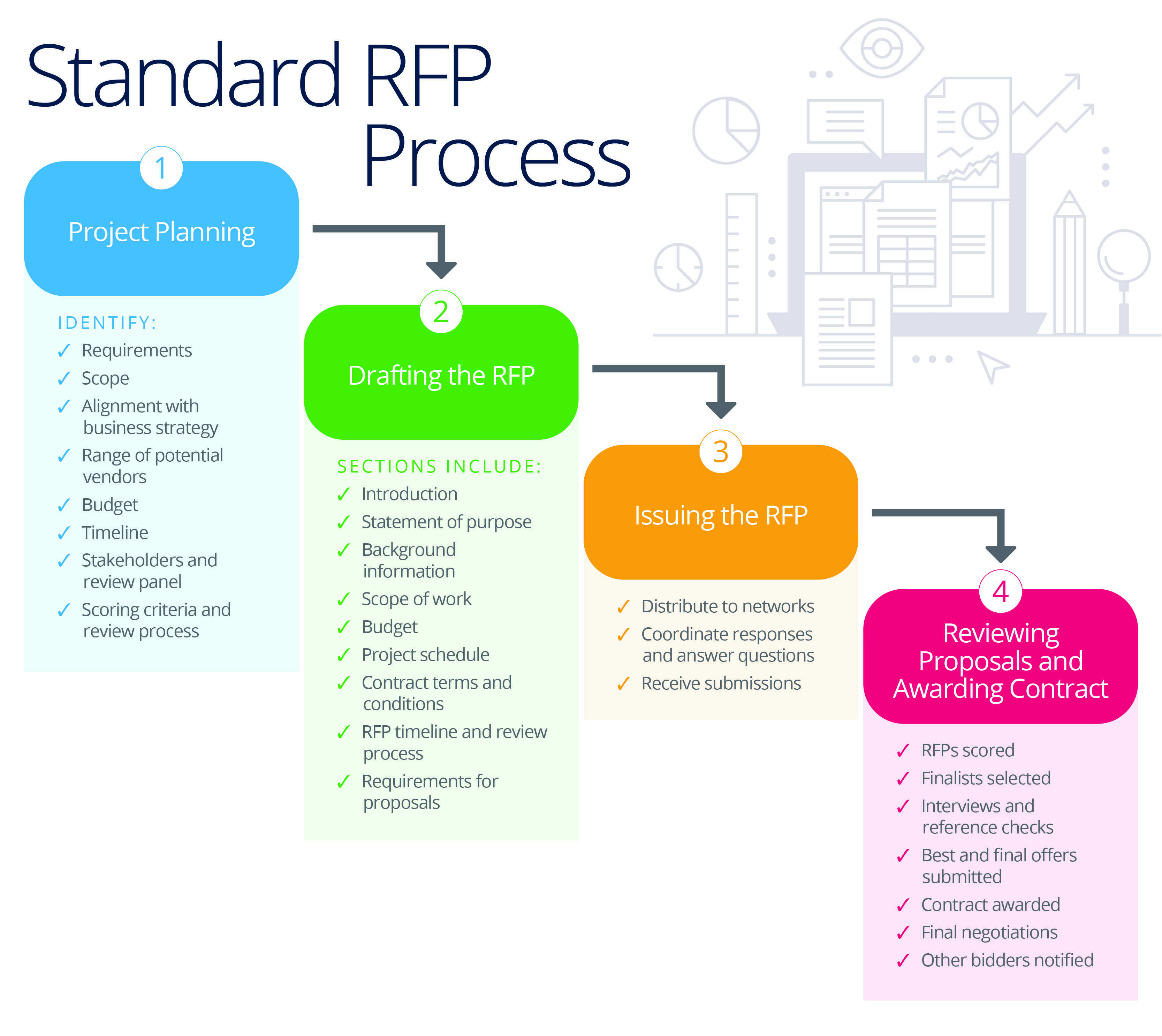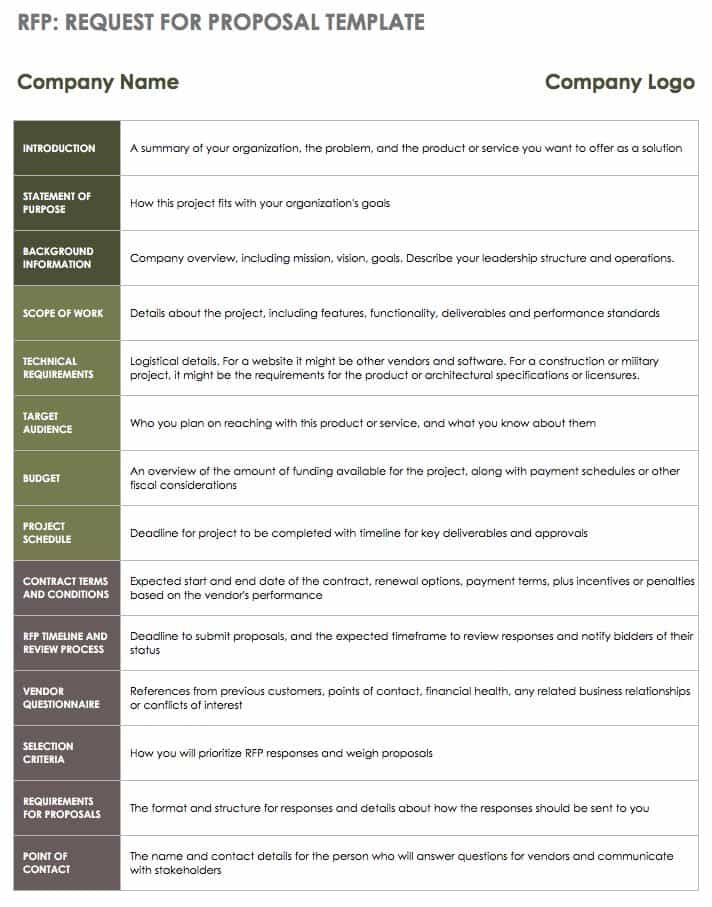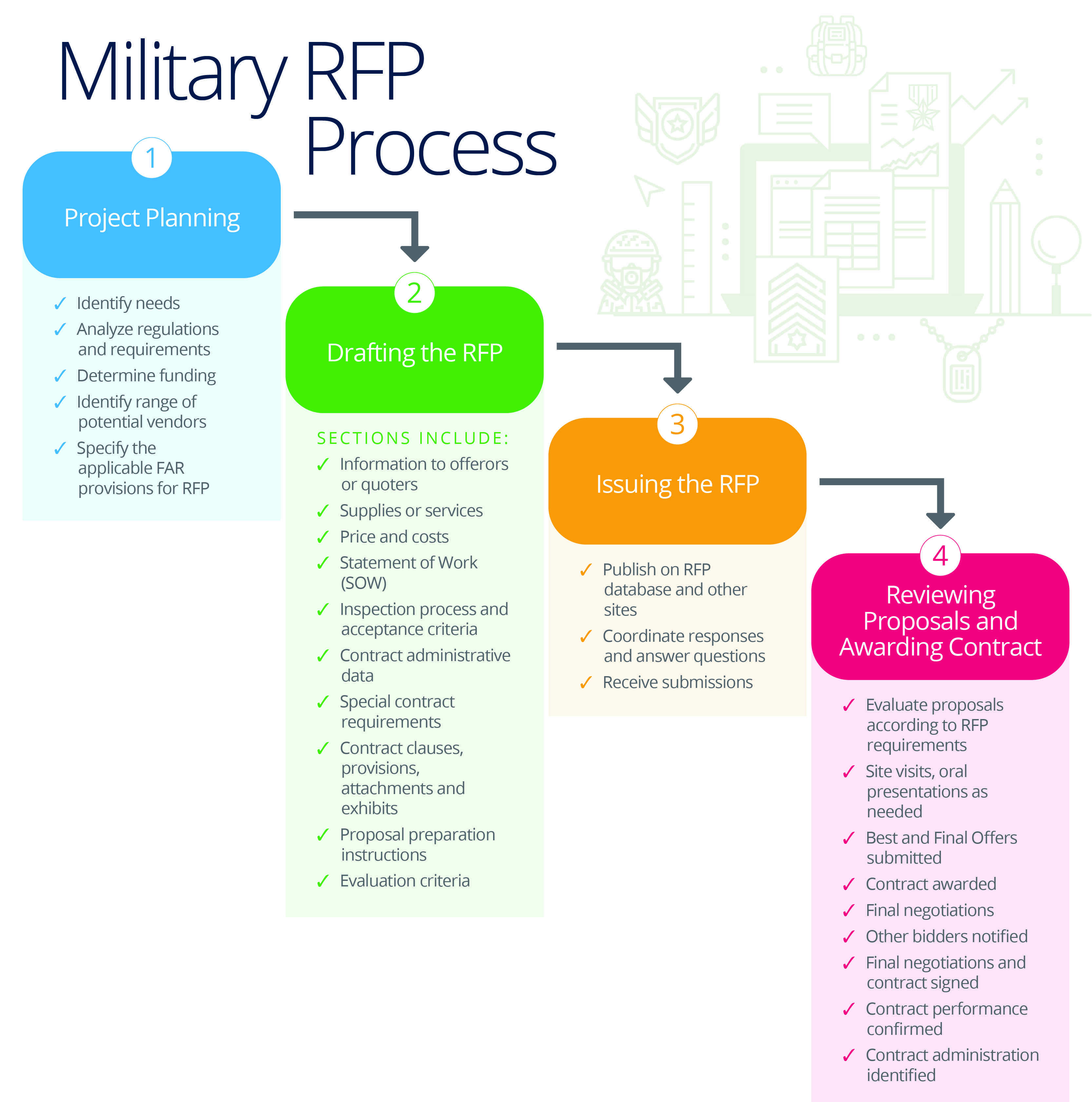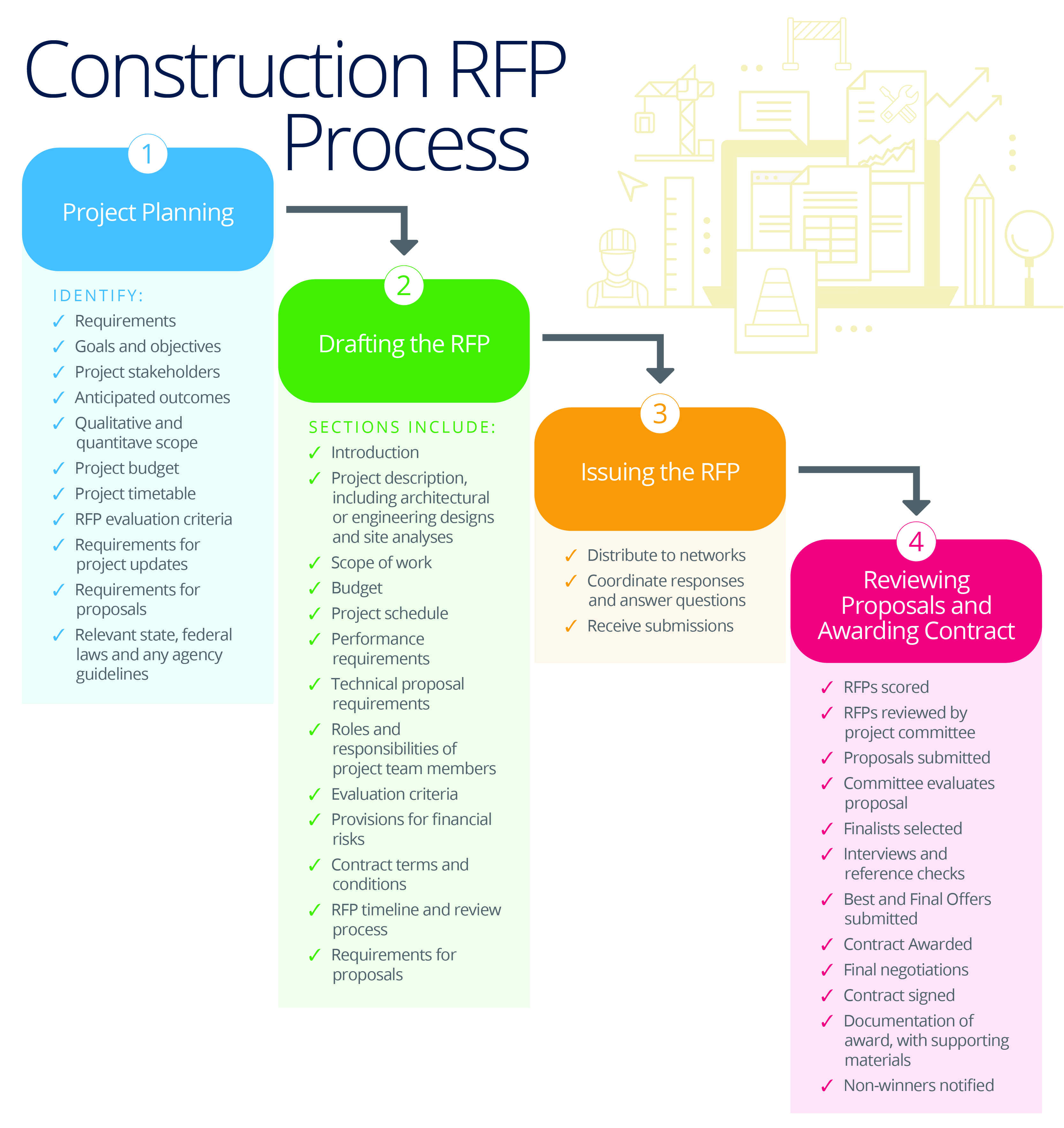What Is an RFP?
A request for proposal (RFP) is a formal document that an organization uses when it wants to buy a product or service. A company publishes the RFP that includes a detailed explanation of what you want and why, and uses it to solicit bids and identify the best partner in developing the product. It is a competitive process in which several companies may submit proposals.
The RFP outlines what your organization is looking for and how it will evaluate proposals. It typically includes information in the following categories:
- Technical: Describe the business objectives of the project and details about the scope of the project including development, standards, outcomes, and deliverables.
- Administrative: Provide information about the company issuing the RFP, including its history, organization, and operations.
- Financial: Outline information about the company's business plan, financial data, and risk analysis.
Reasons for Issuing an RFP
The RFP process is thorough and time-consuming. When funding is available for major initiatives or business goals, companies invest the resources to develop, write, and issue an RFP. The document makes a statement about who you are as a company and where you want to head. It is especially helpful if, as a company, you are looking for the best way to create a product or service that doesn't currently exist.
By definition, you use an RFP when you want to buy a product, but you also use it to announce that, through this competitive process, you want to find the right partner. You also create an RFP to foster an open and transparent process for finding the best solution. It shows you are serious about your business and expect potential partners to offer thoughtful solutions.
How Does a Request for Proposal Work?
An RFP describes the details of the project or service. Issuing an RFP announces that you are looking for a wide range of vendors to provide their best ideas, solutions, and price in a bidding process. The RFP is created and distributed early in the product development cycle because you want the bidders to demonstrate how they will implement your project. The responses will offer insight into the feasibility of the project for your business and help you assess the need for the initiative.
When a company issues an RFP, it takes control of selling process in a system known as complex sales (or enterprise sales). This system is typical when there is a long sales cycle that involves multiple stakeholders. By definition, an RFP requires a proposal from suppliers, so you can control who will be your partner.
The RFP can reveal your business and negotiation strategy. Are you looking for a one-time vendor who can offer a solution to your project, or do you prefer a long-term partner in a range of products that would flow from this initial project? The RFP can also reveal whether there are existing vendors that have developed work for you in the past who may already have the expertise required for this project.
Each company that responds will follow your specifications so you can compare and evaluate the proposals directly. An RFP ensures you will have a clearly defined set of responses that fit the scope of the project that you can asses impartially and without bias. Plus, it helps you identify whether the companies responding to your RFP can actually do the work.
Potential Problems
When issuing an RFP, be aware of potential pitfalls. If you don't distribute the RFP widely enough, you may not receive many responses. Alternatively, the procedures for responding to RFP may be so restrictive that potential vendors may not see the value in bidding on the project. Potential bidders may also see the RFP as tailored to a vendor with whom you've had a pre-existing business relationship, and therefore may not think there's an opportunity for them to win the job. This situation is especially critical in government bids.
That said, you may need to decide whether an RFP is relevant to your business' needs. Here are some factors to consider:
- Responses provide an apples-to-apples comparison of vendors so you can impartially weigh the bids, which reduces any favoritism in hiring a vendor and eliminating guesswork in the product that's delivered.
- If you need transparency in the bidding process (especially critical in government programs), an RFP provides an open and fair practice.
- If you have a pre-existing relationship with a vendor, note that in the RFP. Companies want to know how open the process really is before submitting a proposal.
- Be specific and clear about what you want in a solution. If you make too many assumptions about your project, you may get responses that don’t address all your needs.
- Consider how widely you will distribute the RFP. Receiving too few responses means you won't get many solutions. However, distributing the RFP too widely might leave you wading through many proposals that miss the mark.
Consider these factors before investing the time commitment to write and respond to a request for proposal:
- Do you want to work within the company's business systems and process? Evaluate what the RFP tells you about the company's structure and culture.
- What does the RFP tell you about the company's strategy? How much does the RFP focus on its past or does it outline its vision for building the company? Does the RFP provide a complete picture of how this project fits with the company's goals or are the project's requirements limited to a list of data and deliverables?
- How much do you want to consider this business opportunity? Dig deeply enough into the RFP to go beyond a blanket "like/dislike" reaction to the request.
- What are your odds of winning the contact? Does the issuing company have a pre-existing relationship with a vendor? Can you craft a unique proposal that would meet the organization’s needs?
If you want to get the best companies to respond to your RFP, you must "provide a compelling synopsis of the opportunity and the significance of the work," he adds.
What Is a Request for Proposal in Project Management?
The RFP process gives a company a formal way to get the best products and services for the business. At the same time, it helps vendors find new customers for their solutions and ideas. This process, however, can fall short without strong project management.
A project manager can guide your organization through the RFP process, especially if your company is looking for a complex or customized product or service. The first thing a project manager should do is help identify the specifics of what it wants to purchase. They can address any technical expertise or specialized capabilities required from the bidders. The project manager works with key stakeholders to ensure that the RFP has clear, complete, and achievable requirements.
Once the RFP is written, the project manager coordinates sending out the RFP and manages the responses. This phase of the RFP process is similar to any kickoff in project management. The project manager alerts key internal stakeholders and external clients that the selection process has started and ensures that the process is open, fair, and competitive. The project manager also answers questions, coordinates responses and ensures that suppliers have the information they need to respond to the RFP's requirements.
Submissions should align with the RFP timeline and budget — key goals in project management. If you clearly identify your outcomes, you can use the RFP to negotiate with the finalists. By sticking to the RFP and reviewing the proposals that best fit your needs, you can manage expenses and stick to the project schedule. If the negotiation process is extremely competitive, you may find opportunities to drive down costs and add extra incentives for completing the project ahead of schedule.
The Steps in the Standard RFP Process
The RFP process does not begin with writing the actual document. You must start by understanding what you want and how it fits into your business strategy. Identify the types of solutions and partners you might consider, the actual scope of work, and who will be involved in reviewing submissions, negotiating with the vendor, and monitoring the implementation process. This charts shows the steps in the RFP process.
Project Planning
The first phase of creating an RFP is to identify what you want, what you need, and what is achievable. Get started by asking these questions:
- What are the requirements for your project and what other options would be nice to have?
- What are the boundaries and scope of this project or solution?
- How does this project align with your business' overall short-term and long-term goals, strategy, and objectives?
- Do you have a preferred vendor in mind? How open will you make the submission process?
- What is the budget and timeline for this project?
In this phase, identify and interview the project's stakeholders and advisers. Also consider who will review the RFP submissions and who will be part of the bidding and selection processes. You also need to establish the screening process and scoring criteria, which includes determining the deciding factors as you review submissions and choose a winner.
Once you have identified the key stakeholders, goals, and deliverables, you’re ready to put these details into the written RFP.
Drafting the RFP Proposal
All RFPs cover key information about the product or service you are seeking and the process you will use to find the best supplier. Which details to include vary by industry; some may require a more formal and deliberate process. Note that there is some variation in the RFP process between the public and private sectors.
All RFPs should be clearly organized and include information so people know to bid. Here are the elements common to an RFP in any line of business:
Introduction: An overview of the project, what you hope to achieve along with key points, deliverables, timeframe, and how to respond.
Statement of Purpose: This section explains why your organization needs this project and how it addresses your business need(s). It also describes the goals of the project.
Background Information: Describe your organization's mission and how this project fits with your overall goals. Outline your organization's structure, strengths, and weaknesses to give vendors insight into how they will interact with you during the project. Use this section to describe the audience (and its size) for your product or service. Include customer demographics and other data that will help the vendors understand the scope of the project.
Scope of Work: Specify the project requirements, the work the vendor should perform, and the outcomes and deliverables. Include a detailed list of features and responsibilities, rather than bucketing the work into an overall summary. Be specific with your outcome and performance standards and how you will monitor process and implement any correction action. Creating an itemized list will help you score the responses as they come in, so you can identify who will meet your needs. It will also help you get accurate estimates for the work. Because this will guide the project's development, it's critical that this is clear. In this section, you want to hear the vendors ideas for meeting the RFP, so provide as much guidance as possible. For related guidance, read “How to Write a Statement of Work for Any Industry.”
Budget: Whether you have a fixed dollar amount or a range to spend, be direct in your RFP so those bidding know whether they want to invest their time responding to the document. The budget, and the responses, will help you prioritize the features and help you compare solutions for how companies can achieve what you want within the price range you've identified.
Project Schedule: While you may not know exactly how long the project will take, you want to outline a timeline so the project doesn't drag on. Providing time constraints also lets vendors know how many resources they would have to put against the project to complete it — or whether it is beyond their ability to fulfill.
Contract Terms and Conditions: Describe the length of the contract and any options for renewal. Explain how will you pay the winning vendor and over what time frame. Spell out whether you have incentives for completing the work ahead of schedule or penalties if the project is delayed. This information will be beneficial when you negotiate the final contract.
RFP Timeline and Review Process: Describe the process for receiving bids. Identify the submission deadline and the schedule that you have mapped out for answering questions, reviewing bids, notifying finalists, and beginning work. Explain how the submissions will be reviewed, who will look at them, and what criteria you will use to score the responses. If vendors take the time to bid on your project, you owe them the courtesy of knowing how they will be evaluated and when they will hear back from you.
Point of Contact: Preferably, list just one person who answers questions (or finds the answers). This person can also be the coordinator between the vendors and the project team.
Vendor Questionnaire: You've already asked how a vendor will complete the work. You also want to know about the vendor's company, its organization, practices, and capacity to do the work. It's best to also ask for a few references, so you know more about their ability to work with you based on their experiences with other clients. If they have use cases for similar projects, ask that they include them here.
Requirements for Proposals: Specify how you want vendors to deliver proposals to you. Be sure to include any supporting documents that you want to review. Do you want multiple copies of the proposal; should they be emailed or provided in another digital format? Do you have a specific outline to follow or a set of questions you want them to answer?
Download the Request for Proposal Template
Issuing the RFP
If you have a list of preferred vendors, you can send the RFP to them. Your professional network may help you find additional vendors. Just ask others you've worked with about companies that might be a likely match for this project. If you have seen similar projects completed, do some research and find out who performed that work, as that company may also be interested in your project. Or, if you are looking for a unique approach to your business needs, perform online research to find additional prospective vendors. You may want to post the RFP on your website to gain a broader review and response.
Reviewing Proposals and Awarding the Contract
The selection team will review the proposals. Be sure to include key stakeholders in this process, either as first-hand reviewers or by communicating the progress to ensure the project is still on track. Some companies find it helpful to have a spreadsheet that helps score the bids by assigning point values to each section of the RFP response. Regardless, you're evaluating which vendor can best do the job.
Depending on the scope of the project, you might want a subsequent round of phone or in-person interviews with your finalists. You will be working in partnership with the company that wins the contract, so the meeting can help ensure you will work well together. The meeting is also an opportunity to ask any final questions or ensure that the project is clear to everyone, eliminating any assumptions about the work. During this evaluation of the finalists, do your homework: Research the vendors' track records and check their references.
Once you've got an idea about the finalists and feel comfortable working with more than one of them, you can also consider asking for a second round of responses with their Best and Final Offer (BAFO). This step in the RFP process will ensure that you understand the proposals, minimize the risk of the project's failure, and probably reduce the final cost of the bid. Any changes at this point are considered the Best and Revised Final Offer (BARFO). As you negotiate in this phase, you are preparing for the final work of naming and negotiating a contract with the winner.
After you award the contract to the company with the best solution, you should also notify the companies that you did not choose. You may want to do business with them in the future. Tell them what you liked about their proposal. Every company deserves the courtesy of a response.
Negotiating and Signing the Contract
If you have prepared your request for proposal thoroughly, contract negotiations should be a breeze. From the beginning, you know what your company needs and what you want from the vendor with the winning bid. However, you will probably need to negotiate details and sign a contract that ensures the project's success. The terms of the final contract should cover the following:
- Duties and Rights of Each Party: Be specific about what you expect the vendor to provide and how you will work together. Include handling disputes, especially if one of you wants to end the agreement.
- Project Schedule and Deadlines: Identify the work completion date, any milestones the company should meet during development, the reporting and feedback process, and anything else that will help keep the project on track.
- Deliverables: Throughout the RFP process you've probably adjusted expectations. List the features and functionality that you expect from the vendor and have agreed upon during the negotiation process.
- Payments, Incentives, and Penalties: Outline the payment schedule and invoicing process. If you offer incentives for getting the work done sooner, or at a lower cost, explain the reward, and when and how it will be awarded. You can also include penalties for work that is behind schedule or runs over budget. All these terms need to be clear in the contract.
- Contractual Terms and Conditions: Explain how long the contract is valid, whether it can be re-negotiated or renewed, and any conditions under which either party can end the contract.
- Confidentiality Clause: This clause (also called a Non-Disclosure Agreement or NDA) is used in a variety of contracts, typically so you and your partner can share intellectual property that is necessary for the project. It makes clear what information is public and what’s protected.
Specialized Request for Proposals
Different kinds of businesses in private and public sectors have specialized needs in the RFP process. Here are a few:
Military and Government RFP Process
The U.S. government spends billions of dollars every year to buy products and services. Military purchases typically result from a need to develop or buy equipment or systems, which creates an Operational Requirement (OR). These agencies use several kinds of procurement processes, including sealed bids, simplified acquisition procedures for purchases less than $25,000, and RFPs to fulfill the OR. Typically, an agency issues an RFP when the value of the contract exceeds $100,000. The law requires government agencies to issue these publicly to ensure a full, open and transparent competition, and to consider at least three bids. This flowchart shows the steps in a military RFP process.
Early in the process, the agency may issue a Sources Sought Notice to see which companies are interested in the project and capable of completing the work. Responses to the Sources Sought Notice will help the agency determine its next steps to buy a product or service.
Government agencies use a standard form for RFPs that is guided by Federal Acquisition Regulation (FAR). These regulations define what must be included in an RFP and how to organize it. The guidelines cover everything from the Statement of Work (SOW), to performance criteria, special contract requirements, timeline, opportunity to respond, and proposal preparation instructions.
A key part of the federal RFP process includes the mix of vendors that are eligible to bid. Small businesses and minority-owned businesses may be eligible for some programs or receive some preferences according to guidelines established by the federal government. Companies also must obtain a Data Universal Numbering System (D-U-N-S) number, provided by Dun and Bradstreet, to submit a response.
Government RFPs are publicized on the Federal Business Opportunities (FedBizOpps) website as well as agency sites and other channels. Finalists in the evaluation process may be required to host site visits, make oral presentations, or provide BAFO as spelled out in the RFP. Once the contract is awarded, the negotiations to finalize all the details may take longer than a typical business contract.
RFPs for Websites, Software and IT Solutions
The digital world moves quickly. Software and platforms are always evolving, which means the RFP process focuses on creativity and expertise, more than on a list of technical requirements. These types of companies are looking for a partner to help innovate for their customers and grow their business. Here are some additional topics to tackle in the RFP:
Objectives: In a website RFP, project requirements and scope may be less technical than in other industries. Rather than describe your solution, describe the problem you are trying to solve and the audience you are trying to reach. Responses could offer all kinds of solutions you've never considered.
Functionality: Provide details about what you want users to be able to do. This can include interactive maps, calendars, responsive design, e-commerce, and personalized content.
Web Integrations: More and more, websites and digital organizations depend on a suite of services and vendors that work with a website or system software. Some third-party integrations can include email newsletters (such as MailChimp), customer databases or CRM (such as SalesForce), marketing automation systems, the company intranet (such as SharePoint), accounting software, and more. Your RFP needs to include these systems so potential vendors know the scope of the work to integrate their solution with your other systems. If their work does not include an out-of-the-box solution, they may need to consider writing custom code or hiring subcontractors.
Sitemap: Document the different types of content your site will include as well as its organization. Not only will the sitemap help vendors understand your goals and audience, but it will also guide the project’s implementation as you develop new content, migrate existing content to the new site, and build the templates or layouts for the site and the designs each template will need.
Support: A web project is never really done. You will always want to maximize the value of what you've invested in the platform or software. That starts with training. Don't expect the vendor to hand over the keys and walk away. Your team needs to know how to use what has been built and integrate the new system into your business. Even more, web technologies are always updating and adding features. Consider keeping your partner on a retainer to handle updates, manage traffic, and help grow the features and your business.
Hosting: Different web hosts offer different options and price points. Whether you have a web host already or are open to new solutions, your digital development partner can provide insight into the best hosting solutions — from site backups to security, caching, and speed.
Analytics: This data is critical to know whether your investment in a new site or software system is a success. The vendor can help you decide what to measure and how to do it. Your RFP started with goals for what you wanted to do and who you wanted to reach. Analytics turn your hopes into actionable data.
Startup RFPs
Startups are based on great ideas for a product or service, but you may be a little vague on the details of the business. The RFP process will help you identify what's possible. Just as a business plan aids in describing your company, product, and financial plan, the RFP shapes the vision for your product. And with the RFP responses, you may find a more creative approach to your product and a partner with expertise to help you grow your business.
Once you've identified your goals, you can focus on the features. In the process of developing your RFP, you should distinguish between the "wants" from the "needs" for your product and your business. You need to identify what matters most and prioritize those. A clear requirements section will point you to the best vendor and partner. An RFP is an ideal way to describe a project’s priorities, goals, expectations, deadlines, and deliverables.
Marketing , PR, and Advertising
Responses to creative services RFPs can be difficult to evaluate because they come from creative organizations. Avoid the temptation to adhere to a strict format for these kinds of bids: The RFP should enable agencies to demonstrate their creativity so you can accurately gauge their work is really like.
Be specific in your RFP about what you want. What are your pain points and ultimate goal? Do you need to grow your reach, enhance your lead generation programs, or convert customers in the marketing funnel? Specify where the agency should focus and outline your existing channels.
Additionally, be specific about your target audience and what you want to accomplish with that audience. Share what you know about them, especially if you’ve already developed personas. And if you've had previous successes or failures, share what you've learned about what resonates with that audience.
Construction RFP
Each construction project is different, so it's essential for each RFP to be as detailed as possible in order for you to get complete and realistic responses. Describe the type of building as well as any special materials, components, or features. Also include any mandatory requirements such as permits and taxes, licensing, bonding, and certifications. This flowchart shows the steps in a construction RFP process.
Details in a construction RFP include:
- Architectural or engineering designs
- Site analyses, environmental remediation, and/or other site improvements
- Constraints, schedules, deadlines, mandatory items, and allowable renewals
- Roles and responsibilities of the project team, including the project manager, the contractor and subcontractors, and any independent colleagues such as cost consultants or architects
- Qualifications for the contractor and subcontractors
- Desired or required construction materials
- Any federal or state requirements, including wage labor laws
NonProfit RFP
Nonprofits go through the RFP process to follow their policies or government regulation. RFPs also provide a layer of transparency in managing the funds of their donors and funders. As part of this transparency, nonprofits typically want at least three competitive bids for any project.
Nonprofits are sensitive to how they spend any donated funds, so finding and selecting a trusted vendor is critical in the RFP process. There are several ways to issue an RFP that gets in front of the best vendors. As a nonprofit, you already have a reliable network of other agencies and donors who know your mission and organization. Promote the RFP through these channels as well as through your online community. If you want to work with local vendors, publicize the RFP in local media websites or journals. For a broader reach, the Philanthropy News Digest offers a free service that publishes RFPs for nonprofits and foundations.
What’s Similar to an RFP?
An RFP is just one of the ways companies can get feedback about their ideas for products and services. Here’s a breakdown of other requests you can use to find the best solutions and partners for your business.
Invitation for Bid or Invitation to Bid (ITB): Use this when you have detailed project requirements and want to know how much it will cost to complete the work. Unlike an RFP, the invitation to bid focuses on the price and not on a vendor’s ideas for completing the work or other criteria.
Request for Association or Request for Alliance (RFA): This document is ideal when looking for a business partner to help you with solutions and ideas beyond one project or service. Also called a Request for Collaboration or Request for Partnership, the RFA focuses on how the alliance would mutually benefit both partners and the project would help achieve goals. Typically, the RFA helps you find organizations with complementary business strengths, distribution, audiences, and processes.
Request for Application (RFA): Use this form to announce that you have grant funding and want to invite relevant programs or professionals to bid. A government agency or nonprofit organization typically uses an RFA to specify who is eligible for the grant and what types of programs will receive the funds.
Request for Expressions of Interest (REOI or EOI): Use an REOI, also known as the Registration of Interest (ROI), in the development phases of a project to see who might be interested in the work. An REOI helps test your idea and build interest among vendors who want to help shape your vision. Companies that express interest in the REOI usually want to know about the RFP when it is available, although they are not required to bid.
Request for Information (RFI): The information in this document will help you get to know prospective suppliers and build a database of vendors that will be useful when executing your strategy. You can gather information about trends in the marketplace, the state of the market and factors that are affecting it, and the scope of competition among suppliers. You can also gather data about each supplier, including products and services, facilities and finances, and pricing strategies and product plans. When you’re done, you should have a solid list of vendors that can fulfill any of your business requirements and might be interested in your RFP.
Request for Quotation (RFQ): List the project details, including descriptions, quantities, and other variables. Vendors offer their best price based on this standardized RFQ. Then you can compare the quotes and get the best deal with minimum negotiation. This RFQ is typically part of a sealed bid or is a supplemental document in the RFP.
Request for Qualifications (RFQ): Also known as a pre-qualification questionnaire, the RFQ helps you screen prospective vendors and identify those who are most qualified. This typically is used early in the product cycle, so you can find eligible vendors for the RFP process. If your project is straightforward, an RFQ may be enough to find the best vendor. Some agencies, such as the Federal Highway Administration, require an RFQ as part of the procurement process.
Request for Solution (RFS): If you are open to innovative solutions, consider an RFS. Unlike a RFP, which typically provides details about the product or service, the requirements in an RFS are less specific, which gives vendors more leeway to offer creative ideas.
Request for Tender (RFT) or Invitation to Tender (ITT): An RFT invites companies to submit bids to supply specific products or services. An RFT can be based on the criteria in an RFP and it may ask some of the same questions as an RFI. Public sector organizations and major construction projects tend to use these because project managers already know what they want.
How to Write an RFP
While many government RPFs follow a strict format and are circulated regularly to the same client base, civilian RPFs need to get the attention of credible firms. For that reason, they need to adhere to professional writing standards. Use clear language free of jargon and include full descriptions. It helps if you are not listing merely a set of requirements, but are aspirational in what you hope to accomplish with the project and how it fits your overall mission and goals as an organization. "Especially in the nonprofit world, aspirational RFPs are appealing," explains Shen.
You will receive better bids if you have written a clear RFP. You may fail in receiving sound bids if you are vague. Here are some other tips:
- Write an Outline: Before digging into the details for each RFP section, map out what goes in each area and address any unanswered questions.
- Use a Template: An RFP is packed with information. Use a template to ensure consistent formatting that is easy for potential bidders to follow and digest.
- Create Compelling Content: Tell the story of your company and how this project will accomplish its goals. You want to find vendors who share your vision and can work as a partner and not merely as a vendor.
- Review and Revise the RFP: Once you draft the RFP, circulate it among key stakeholders and trusted partners to ensure objectives are clear and have addressed any concerns. Their feedback will help you craft compelling copy.
Where to Find Request for Proposals
While going through the RFP process, look for RFPs for similar projects or in similar areas of business. Not only are you looking at the competition to see what the products are services are in their pipeline, but you can also see how they organize RFPs, the language they use to describe their product and their business, and the information they seek from potential bidders. Here are some places to look:
- RFP Database lists requests for proposals, bid opportunities, and the latest project offerings in the U.S., Canada, and the European Union. Categories include business services, construction, creative, health and human services, professional services, research and development, supplies and technology.
- Onvia is a fee-based site that list open RFPs.
- Professional organizations, such as the Public Relations Society of America, list RFPs relevant to that sector.
- Cubeyou monitors marketing and advertising news to gather new RFPs in a free subscription service.
- RFP Zone lists public sector RFPs from U.S., Canada, and the UK in a free subscription service.
- Most federal request for proposals are listed in the Federal Business Opportunities database.
- FindRFP lists federal, state and local government RFPs and bidding opportunities.
Improve Your Request for Proposal Process with Smartsheet
Empower your people to go above and beyond with a flexible platform designed to match the needs of your team — and adapt as those needs change.
The Smartsheet platform makes it easy to plan, capture, manage, and report on work from anywhere, helping your team be more effective and get more done. Report on key metrics and get real-time visibility into work as it happens with roll-up reports, dashboards, and automated workflows built to keep your team connected and informed.
When teams have clarity into the work getting done, there’s no telling how much more they can accomplish in the same amount of time. Try Smartsheet for free, today.






